Flora of New York/Crossosomatales, Sapindales
| ← Myrtales |
Flora of New York — Crossosomatales, Sapindales | → Malvales | |||
| Table of contents |
Genus index |
Protected species index | Invasive species index | ||
| Clades | Order | Family | Subfamily | Tribe | Genus | Common names | # |
|---|---|---|---|---|---|---|---|
| angiosperms: eudicots: rosids: malvids |
Crossosomatales | Staphyleaceae | — | — | Staphylea | bladdernut | 1 |
| Sapindales | Anacardiaceae | Anacardioideae | Rhoeae | Rhus | sumac | 5 | |
| Toxicodendron | poison ivy, poison oak, poison sumac | 4 | |||||
| Cotinus | smoketree | 2 | |||||
| Sapindaceae | Hippocastanoideae | Acereae | Acer | maple | 15 | ||
| Hippocastaneae | Aesculus | buckeye, horse chestnut | 2 | ||||
| Sapindoideae | Koelreuterieae | Koelreuteria | golden rain tree | 1 | |||
| Paullinieae | Cardiospermum | balloon vine | 1 | ||||
| Simaroubaceae | — | Ailantheae | Ailanthus | tree-of-heaven, Chinese sumac | 1 | ||
| Rutaceae | Rutoideae | — | Ruta | rue | 1 | ||
| Toddalioideae | — | Zanthoxylum | prickly ash | 1 | |||
| Ptelea | hop tree | 1 | |||||
| Phellodendron | Amur cork tree | 1 | |||||
| Dictamnus | gas plant | 1 | |||||
| Meliaceae | Melioideae | Melieae | Melia | Chinaberry tree | 1 |
Order Crossosomatales
[edit | edit source]The Crossosomatales Takht. ex Reveal (1993) is a small order[1] that has a single native species in New York.[2]
|
Family Staphyleaceae
[edit | edit source]The Staphyleaceae (bladdernut family) has been placed in Sapindales as recently as 1981 (Cronquist) and 1997 (Takhtajan).[1] Only one species of this family is found in New York.[2]
|
Staphylea
[edit | edit source]| Genus Staphylea | Bladdernut | N.Y. Status | Images | Distribution | NY NPT |
L. 1753. Staphylea trifolia L. 1766. Staphylodendron trifoliatum Crantz |
American bladdernut, Bladder nut Staphylier à trois folioles, Staphylier trifolié |
Native, CoC: 7, Secure FAC Perennial, Tree, shrub, Shade |

|
NYFA: 5 |
USDA-NN Go Botany VASCAN ARS-GRIN ITIS Tropicos BONAP LBJ Images Wikispecies |
|
| |||||
Order Sapindales
[edit | edit source]| The order Sapindales
|
Family Anacardiaceae
[edit | edit source]The Anacardiaceae (cashew or sumac family) ...[1]
|
Subfamily Anacardioideae
[edit | edit source]Rhus
[edit | edit source]| Genus Rhus | Sumac | N.Y. Status | Images | Distribution | NY NPT |
L. 1753. Datisca hirta L. (i)
1756. Rhus typhina L.
1768. Rhus canadensis Mill.
1847. Rhus typhina var. lacinata Alph. Wood
1891. Toxicodendron typhinum Kuntze
1892. Rhus americana Dippel
1892. Rhus hirta (L.) Sudw. (i)
1894. Rhus frutescens Hort (i)
1903. Schmaltzia hirta (L.) Small (i) |
Staghorn sumac, Stag's-horn sumac, Velvet sumac, Vinegar tree Sumac vinaigrier, Sumac amaranthe, Vinaigrier |
Native, CoC: 1, Secure UPL Perennial, Tree, shrub |

|
NYFA: 5 |
USDA-NN COL POWO Go Botany VASCAN ARS-GRIN ITIS Tropicos BONAP Images Wikispecies |
L. 1753. Rhus glabra L. |
Smooth sumac | Native, CoC: 3, Secure UPL Perennial, Tree, shrub |

|
NYFA: 5 |
USDA-NN Go Botany ITIS BONAP LBJ Images Wikispecies |
L. var. copallinum1753. Rhus copallinum L. |
Winged sumac | Native, CoC: 7, Secure FACU-UPL Perennial, Tree, Shrub |

|
NYFA: 5 |
USDA-NN BONAP LBJ Images Wikispecies |
L. var. latifolia Engl.1883. Rhus copallinumvar. latifolia 1891. Toxicodendron copallinum var. latifolium |
Broadleaf winged sumac | Native, CoC: 7, No reports FACU-UPL Perennial, Tree, Shrub |

|
Oswego (1922) NYFA: U |
USDA-NN BONAP Images Wikispecies |
Aiton var. aromatica1789. Rhus aromatica Aiton |
Fragrant sumac | Native, CoC: 7, Secure UPL Perennial, Shrub |

|
NYFA: 5 |
USDA-NN ARS-GRIN ITIS BONAP LBJ Images Wikispecies |
| var. arenaria 1905. Schmaltzia arenaria Greene
1937. Rhus trilobata var. arenaria (Greene) F.A.Barkley
1940. Schmaltzia trilobata var. arenaria (Greene) F.A.Barkley
1941. Rhus aromatica var. arenaria (Greene) Fernald
1945. Rhus arenaria (Greene) G.N.Jones |
Fragrant sumac | N. America native US midwest, N.Y. excluded |

|
NYFA-Excluded |
USDA-N0 Tropicos Images Wikispecies |
Greene (pro sp.) Rhus glabra × Rhus typhina 1901. Rhus glabravar. borealis 1906. Rhus borealis Greene 1908. Rhus pulvinata Greene |
Northern sumac, Pulvinate sumac, Hybrid of smooth sumac & staghorn sumac |
Native, Threatened |

|
NYFA: 2? |
USDA-NN Tropicos Images Wikispecies |
|
| |||||
Toxicodendron
[edit | edit source]| Toxicodendron contains the native, but often unwelcome, poison ivy, poison oak, and poison sumac trio. All of these produce the resin urushiol which can cause severe skin and mucous-membrane irritation in those who have a sensitivity to it.
|
Toxicodendron sect. Toxicodendron
[edit | edit source]| While both eastern poison-ivy (T. radicans) and western poison-ivy (T. rydbergii) are rhizomatous and may occur as low shrubs, only eastern poison-ivy has aerial roots, allowing it to also occur as a trailing or climbing liana.[1]
Eastern poison-ivy — In North America in general, T. radicans ssp. radicans occurs primarily east of the Appalachian Mountains and can be considered as a coastal taxon, while ssp. negundo occurs primarily west of the Appalachians. In New York, ssp. radicans occurs primarily in the southeast part of the state and up the Hudson Valley, while ssp. negundo occurs in the western and central parts of the state.[2] Western poison-ivy — Toxicodendron rydbergii is closely related to eastern poison-ivy, and despite its morphological differences and lack of climbing ability, may still be considered a subspecies or variety of T. radicans.
|
| T. radicans | Leaflets | Petioles | Drupes | Stems |
|---|---|---|---|---|
| ssp. radicans | fairly flat, underside glabrous except on main veins; tufts of hair on vein axils | glabrous | pubescent, scabrous, or papillose | may have aerial roots |
| ssp. negundo | fairly flat, underside softly pubescent | pubescent | usually glabrous | may have aerial roots |
| ssp. rydbergii | thicker, somewhat folded, underside glabrous to sparsely strigose, upper surface glabrous | glabrous | larger, glabrous | without aerial roots |
| Genus Toxicodendron Mill. sect. Toxicodendron | Poison ivy | N.Y. Status | Images | Distribution | NY NPT |
(L.) Kuntze ssp. radicans 1753. Rhus radicans L. 1768. Toxicodendron vulgare Mill. 1891. Toxicodendron radicans Kuntze 1902. Rhus littoralis Mearns 1924. R. radicansvar. littoralis Deam 1941. R. radicansvar. malacotrichocarpa Fernald |
Eastern poison ivy Herbe à puce de l'Est |
Native, CoC: 3, Secure FAC Perennial, Herb-forb, Vine, Shrub, Subshrub |

|
NYFA: 5 |
USDA-NN Go Botany VASCAN ARS-GRIN ITIS Tropicos NatureServe BONAP Images Wikispecies |
(L.) Kuntze ssp. negundo (Greene) Gillis 1905. Toxicodendron negundo Greene 1971. T. radicansssp. negundo 1990. T. radicansvar. negundo |
Midwestern poison ivy, Eastern poison ivy |
Native, CoC: 3, Unranked FAC Perennial, Herb-forb, Vine, Shrub, Subshrub |

|
NYFA: U |
USDA-NN Go Botany VASCAN ITIS Tropicos BONAP Images Wikispecies |
(Small ex Rydb.) Greene 1900. Rhus rydbergii Small ex Rydb. 1905. Toxicodendron rydbergii Greene 1927. Rhus toxicodendronvar. rydbergii Garrett 1939. Rhus radicansvar. rydbergii 1961. T. radicansvar. rydbergii [1]1981. Rhus radicansssp. rydbergii 1982. T. radicansssp. rydbergii |
Western poison ivy, Rydberg's poison ivy, Northern poison oak Herbe à puce de Rydberg, Sumac de Rydberg |
Native, CoC: 4, Vulnerable FAC Perennial, Herb-forb, Vine, Shrub, Subshrub |

|
NYFA: 3? |
USDA-NN Go Botany VASCAN ARS-GRIN ITIS Tropicos NatureServe BONAP Images Wikispecies |
| Genus Toxicodendron sect. Toxicodendron (excluded taxa) | Poison ivy | N.Y. Status | Images | Distribution | NY NPT |
Mill. 1768. T. pubescens Mill.
|
Atlantic poison oak ⓘ
Eastern poison-oak ⓘ
|
N. America native southeast U.S., N.Y. excluded |

|
NYFA-Excluded |
USDA-N0 Images Wikispecies |
Toxicodendron sect. Venenata
[edit | edit source]| Genus Toxicodendron Mill. sect. Venenata | Poison sumac | N.Y. Status | Images | Distribution | NY NPT |
(L.) Kuntze |
Poison sumac | Native, Likely secure, Perennial, Shrub-tree |

|
NYFA: 4 |
USDA-NN Go Botany ITIS Images Wikispecies |
|
| |||||
Cotinus
[edit | edit source] |
| Genus Cotinus | Smoke tree | N.Y. Status | Images | Distribution | NY NPT |
Scop. 1753. Rhus cotinus L. 1771. Cotinus coggygria Scop. 1891. Cotinus cotinus Sarg. |
Smoketree, Smokebush, Venetian sumac, Wigtree |
Introduced from Eurasia, Not naturalized |

|
NYFA: X |
USDA-XX ARS-GRIN Tropicos Images Wikispecies |
Raf. 1840. Cotinus obovatus Raf. 1849. Cotinus americanus Nutt. 1859. Rhus cotinoides Nutt. ex J.G.Cooper 1892. Rhus americana Sudw. 1894. Cotinus cotinoides Britton |
American smoketree, Chittamwood |
Introduced from US South, N. America native, Cultivated in NY, Not naturalized Perennial, Tree, shrub |
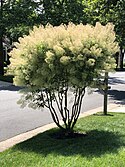
|
NYFA: 0 |
USDA-N0 Go Botany ARS-GRIN ITIS Tropicos NatureServe BONAP Images Wikispecies |
|
| |||||
Family Sapindaceae
[edit | edit source]The Sapindaceae (soapberry family) ...[1]
Subfamily Hippocastanoideae
[edit | edit source]Tribe Acereae
[edit | edit source]Acer
[edit | edit source]| The genus Acer is represented by about fifteen native or naturalized species in New York. These species are here separated into sections following de Jong (2002).[2] These sections are further organized into three tables corresponding to the three clusters (aceroid, palmatoid, and platanoid) described by Grimm et. al. (2006).[3]
Most Acer species go by the common name maple, and all have opposite leaves. Maples are represented by the initial letter 'M' in the mnemonic "MADCap Horse," which can be used to remember which trees have opposite leaves. The other opposite-leave trees represented are Ash, Dogwood, Caprifoliaceae, and Horse chestnut. Of course there are exceptions.
|
Aceroid sect. Acer
[edit | edit source] Sugar maple (Acer saccharum) and black maple (Acer nigrum) are often treated as conspecific,[1] with black maple identified as a subspecies of sugar maple. There are significant morphological differences, but little genetic difference between the two trees, which commonly hybridize. So it's thought that the morphological differences may be more the result of local conditions.[2] The range of black maple does not extend much farther east than New York, while sugar maple is common in both New England and the Mid-west. The Eurasian sycamore maple (Acer pseudoplatanus), also in the Acer section, is not common in New York, but it can become weedy and is now prohibited due to its demonstrated invasive potential.
|
| Genus Acer sect. Acer ser. Saccharodendron | Maple | N.Y. Status | Images | Distribution | NY NPT |
Marshall var. saccharum1785. Acer saccharum Marshall in Arbust. Amer.:4 |
Sugar maple, Hard maple, Rock maple Érable à sucre, Érable franc, Érable franche |
Native, Secure FACU Perennial, Tree |

|
NYFA: 5 |
USDA-NN Go Botany VASCAN ARS-GRIN Images Wikispecies |
F.Michx. 1818. Acer nigrum F.Michx. in N.Amer.Sylv.Illustr. 2:238 |
Black maple, Black sugar maple Érable noir |
Native, Secure FACU Perennial, Tree |

|
NYFA: 5 |
USDA-NN Go Botany VASCAN ARS-GRIN Tropicos LBJ Images Wikispecies |
Acer nigrum × saccharum Acer nigrum × Acer saccharum |
Hybrid of black maple & sugar maple Hybride de érable noir et de érable à sucre |
Native, Unranked |

|
VASCAN Images Wikispecies | |
| Genus Acer sect. Acer ser. Acer | Maple | N.Y. Status | Images | Distribution | NY NPT |
L. 1753. Acer pseudoplatanus L. in Sp. Pl.:1054 |
Sycamore maple, False planetree Érable sycomore |
Introduced from Eurasia, Highly invasive, NYIS: 71%[1], iMapInvasives, Prohibited[2], CP-5[3] NE-4[4] |

|
NYFA: X |
USDA-XX Go Botany VASCAN Images Wikispecies |
| |||||
Aceroid sect. Rubra
[edit | edit source] |
| Genus Acer sect. Rubra | Maple | N.Y. Status | Images | Distribution | NY NPT |
L. 1753. Acer saccharinum L. in Sp. Pl.: 1055 |
Silver maple
Soft maple
White maple
River maple
Water maple Érable argenté
Érable blanc
Plaine blanche
|
Native, Secure FACW Perennial, Tree |

|
NYFA: 5 |
USDA-NN VASCAN ARS-GRIN ITIS Tropicos Images Wikispecies |
L. var. rubrum1753. Acer rubrum L. in Sp. Pl.:1055 |
Red maple Soft maple Swamp maple Eastern red maple Scarlet maple Érable rouge |
Native, Secure FAC Perennial, Tree |

|
NYFA: 5 |
USDA-NN Go Botany VASCAN ARS-GRIN ITIS Images Wikispecies |
L. var. trilobum Torr. & A.Gray ex K.Koch1788. Acer carolinianum Walter in Fl. Carol.:251 |
Carolina red maple Three-lobed red maple Trident red maple Érable trilobé |
Native, Vulnerable FACW-OBL Perennial, Tree |

|
NYFA: 3-4 |
USDA-NN Go Botany VASCAN ARS-GRIN ITIS Images Wikispecies |
A.E.Murray Acer rubrum × Acer saccharinum 1969. Acer × freemani A.E.Murray |
Freeman maple, Freeman's maple, Soft maple |
Native, Threatened |

|
NYFA: 2 |
USDA-NN ARS-GRIN ITIS Tropicos Images Wikispecies |
|
| |||||
Aceroid sect. Ginnala
[edit | edit source]| Genus Acer sect. Ginnala | Maple | N.Y. Status | Images | Distribution | NY NPT |
Maxim. 1856. Acer ginnala Maxim. 1857. Acer tataricumvar. laciniatum 1859. Acer tataricumvar. ginnala 1890. Acer tataricumssp. ginnala |
Amur maple, Ginnala maple Érable du fleuve Amour |
Introduced from east Asia, Moderately invasive, NYIS: 66%[1], iMapInvasives, CP-3[2] NE-4[3], WW |

|
NYFA: X |
USDA-XX Go Botany ARS-GRIN Tropicos Images Wikispecies |
| |||||
Aceroid sect. Pentaphylla
[edit | edit source] |
| Genus Acer sect. Pentaphylla | Maple | N.Y. Status | Images | Distribution | NY NPT |
Miq. 1865. Acer buergerianum Miq. auct. Acer trifidum non Thunb. (1784) |
Trident maple | Introduced from China, Taiwan, Cultivated, Not naturalized |
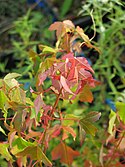
|
NYFA: U |
USDA-00 ARS-GRIN Tropicos Images Wikispecies |
(Franch.) Pax 1894. Acer nikoensevar. griseum 1902. Acer griseum (Franch.) Pax |
Paperbark maple, Chinese paperbark maple |
Introduced from China, Cultivated, Not naturalized |

|
NYFA: U |
USDA-00 ARS-GRIN Tropicos Images Wikispecies |
|
| |||||
Palmatoid sect. Negundo
[edit | edit source]| Genus Acer sect. Negundo | Boxelder maple | N.Y. Status | Images | Distribution | NY NPT |
L. var. negundo1753. Acer negundo L. 1794. Negundo aceroides (L.) Moench 1882. Negundo negundo (L.) Karst. |
Box-elder, Manitoba maple, Ash-leaved maple Érable à Giguère, Érable négondo, Érable argilière |
Native, CoC: 1, Secure, Note [1] FACW-FAC Perennial, Tree |

|
NYFA: 5 |
USDA-NN Go Botany VASCAN ARS-GRIN Tropicos BONAP Images Wikispecies |
| Genus Acer (excluded taxa) | Boxelder maple | N.Y. Status | Images | Distribution | NY NPT |
L. var. violaceum (G.Kirchn.) H.Jaeger1864. N. aceroidesvar. violaceum 1884. Acer negundovar. violaceum 1908. Acer violaceum Simonk. 1982. Negundo aceroidesssp. violaceus W.A.Weber |
Box elder | Native, CoC: 1, Unranked, Note:[2] FACW-FAC Perennial, Tree |
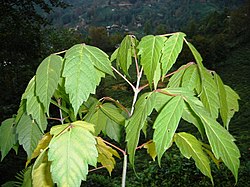
|
NYFA: ? |
USDA-N0 Go Botany VASCAN ARS-GRIN ITIS Tropicos Images Wikispecies |
| |||||
Palmatoid sect. Spicata
[edit | edit source]| Genus Acer sect. Spicata | Maple | N.Y. Status | Images | Distribution | NY NPT |
Lam. 1771. Acer pensylvanicum Du Roi non L. 1784. Acer parviflorum Ehrh. non Franch. & Sav. 1786. Acer spicatum Lam. 1811. Acer montanum W.T.Aiton non Lam. |
Mountain maple, Moose maple, White maple Érable à épis, Érable bâtard, Plaine bâtarde, Plaine bleue |
Native, Likely secure |

|
NYFA: 4-5 |
USDA-NN Go Botany ARS-GRIN ITIS Tropicos Images Wikispecies |
|
| |||||
Palmatoid sect. Palmata
[edit | edit source]| Japanese maple, a popular ornamental tree has been found to naturalize in forest understories in the southeastern part of the state, and is considered invasive there.
|
| Genus Acer sect. Palmata | Maple | N.Y. Status | Images | Distribution | NY NPT |
Thunb. 1784. Acer palmatum Thunb. 1867. Acer sanguineum Carrière |
Japanese maple | Introduced from temperate Asia, Moderately invasive, NYIS: 50%[1], iMapInvasives, NE-4[2] VT |

|
NYFA: X |
USDA-XX Go Botany ARS-GRIN ITIS Images Wikispecies |
| |||||
Platanoid sect. Macrantha
[edit | edit source]| Genus Acer sect. Macrantha | Snakebark maple | N.Y. Status | Images | Distribution | NY NPT |
L. 1753. Acer pensylvanicum L. 1755. Acer canadense Duhamel 1771. Acer striatum Du Roi |
Striped maple, Green-striped maple, Moosewood, Whistlewood, Goosefoot maple, Pennsylvania maple Èrable de Pennsylvanie |
Native, CoC: 7, Secure FACU Perennial, Shrub-tree, Part shade - shade |

|
NYFA: 5 |
USDA-NN Go Botany VASCAN ARS-GRIN Tropicos Images Wikispecies |
|
| |||||
Platanoid sect. Platanoidea
[edit | edit source]| Genus Acer sect. Platanoidea | Maple | N.Y. Status | Images | Distribution | NY NPT |
L. |
Norway maple | Introduced, Very highly invasive, NYIS: 82%[1], iMapInvasives, Regulated[2], CP-2[3] NE-1[4] |

|
NYFA: X |
USDA-XX Images Wikispecies |
| Hedge maple, Field maple |
Introduced, Moderately invasive, CP-3[5] |

|
NYFA: X |
USDA-X Images Wikispecies | |
Bunge 1833. Acer truncatum Bunge Acer platanoidesvar. truncatum |
Painted maple, Shantung maple, Purple-blow maple |
Introduced from temperate Asia |

|
NYFA: U |
ARS-GRIN Tropicos Images Wikispecies |
| |||||
Tribe Hippocastaneae
[edit | edit source]Aesculus
[edit | edit source]The genus Aesculus is sometimes included in its own Hippocastanaceae (horse chestnut or buckeye family).
Aesculus sect. Aesculus
[edit | edit source] horse chestnut Horse chestnuts are commonly planted in New York State. The New York Flora Atlas questions whether they truly naturalize or just repeatedly escape cultivation. |
| Genus Aesculus sect. Aesculus | Horse chestnut | N.Y. Status | Images | Distribution | NY NPT |
| Horse chestnut | Introduced from S.E. Europe, Potentially invasive, CP-5[1], WW |

|
NYFA: X |
USDA-XX Go Botany NatureServe BONAP Images Wikispecies | |
| |||||
Aesculus sect. Pavia
[edit | edit source] Ohio buckeye |
| Genus Aesculus sect. Pavia | Buckeye | N.Y. Status | Images | Distribution | NY NPT |
Willd. var. glabra |
Ohio buckeye | Introduced from US Midwest, N. America native, Unknown naturalization |

|
NYFA: X NYFA: 11 counties ? counties |
USDA-NN Go Botany NatureServe BONAP Images Wikispecies |
Sol. 1778. Aesculus flava Sol. 1785. Aesculus octandra Marshall |
Yellow buckeye, Sweet buckeye, Big buckeye Marronnier jaune |
Introduced from US South, N. America native, Naturalized Perennial, Shrub-tree |

|
Madison (2020) NYFA: nn |
USDA-N0 Go Botany-0 ARS-GRIN NatureServe BONAP Images Wikispecies |
Walter 1788. Aesculus parviflora Walter |
Bottlebrush buckeye Pavier blanc |
N. America native US South, Not naturalized, Cultivated Perennial, Shrub-tree |
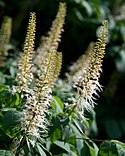
|
NYFA: Xm NYFA: Rensselaer (2000) iNat 8 counties |
USDA-N0 Go Botany-0 ARS-GRIN NatureServe BONAP Images Wikispecies |
L. 1753. Aesculus pavia L. |
Red buckeye Pavier rouge |
N. America native US South, No specimens, Cultivated |

|
NYFA: 0 NYFA: not listed 5 counties |
USDA-NX ARS-GRIN NatureServe BONAP Images Wikispecies |
|
| |||||
Aesculus sect. Aesculus × Pavia
[edit | edit source] |
| Genus Aesculus sect. Aesculus × Pavia | Cross-sect. hybrid | N.Y. Status | Images | Distribution | NY NPT |
J.Zeyh. Aesculus hippocastanum × Aesculus pavia 1818. Aesculus × carnea J.Zeyh.
1822. Aesculus × carnea Hayne
1822. Aesculus × rubicunda Loisel.
1892. Aesculus floribunda Hort. ex Dippel
1892. Aesculus × floribunda Dippel |
Red horse-chestnut ⓘ
Red horsechestnut
Hybrid of |
Introduced, No specimens, Cultivated Perennial, Tree |

|
NYFA: not listed iNat GBIF 11 counties |
COL WFO POWO Images Wikispecies |
|
| |||||
Subfamily Sapindoideae
[edit | edit source]Tribe Koelreuterieae
[edit | edit source]Koelreuteria
[edit | edit source]| Genus Koelreuteria | Koelreuteria | N.Y. Status | Images | Distribution | NY NPT |
Laxm. |
Golden raintree ⓘ
Golden rain-tree
Goldenrain tree ⓘ
Pride-of-India ⓘ
China tree ⓘ
|
Introduced from eastern Asia, Highly invasive, Naturalized |

|
NYFA: 7 counties NYFA: X |
USDA-X0 ARS-GRIN Images Wikispecies |
|
| |||||
Tribe Paullinieae
[edit | edit source]Cardiospermum
[edit | edit source]| Genus Cardiospermum | Balloonvine | N.Y. Status | Images | Distribution | NY NPT |
L. 1753. Cardiospermum halicacabum L. |
Balloon vine, Heartseed, Heart-pea, Love in a puff |
Introduced, Potentially invasive, Not naturalized, Noxious US South |
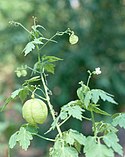
|
NYFA: X NYFA: 2 counties New York (2021) |
USDA-XX Go Botany ARS-GRIN BONAP Images Wikispecies |
|
| |||||
Family Simaroubaceae
[edit | edit source]The Simaroubaceae (quassia family) is represented by a single species persisting outside of cultivation in New York.
Ailanthus
[edit | edit source]| Genus Ailanthus Desf. | Ailanthus | N.Y. Status | Images | Distribution | NY NPT |
(Mill.) Swingle (1916) Ailanthus glandulosa Desf. |
Tree-of-heaven, Chinese sumac, Varnish-tree, Copa-tree Vernis de la Chine |
Introduced from temperate China, Highly invasive, NYIS: 68%[1], iMapInvasives, CP-2[2] NE-1[3] |

|
NYFA: X |
USDA-XX Go Botany ARS-GRIN ITIS Images Wikispecies |
| |||||
Family Rutaceae
[edit | edit source]The Rutaceae (rue or citrus family) ...
Subfamily Rutoideae
[edit | edit source]Ruta
[edit | edit source] |
| Genus Ruta | Rue | N.Y. Status | Images | Distribution | NY NPT |
L. 1753. Ruta graveolens L. 1770. Ruta hortensis Mill. |
Rue, Common rue, Garden rue, Herb-of-grace Rue des jardins, Rue officinale, Rue fétide |
Introduced from Europe, Not naturalized |

|
NYFA: X NYFA: 3 counties 6 counties |
USDA-XX Go Botany VASCAN ARS-GRIN ITIS Tropicos Images Wikispecies |
|
| |||||
Subfamily Toddalioideae
[edit | edit source]| The foliage of the two New York native members of this subfamily, prickly-ash (Zanthoxylum americanum) and wafer-ash (Ptelea trifoliata), are important food for giant swallowtail (Papilio cresphontes) caterpillars.
|
Zanthoxylum
[edit | edit source] prickly ash |
| Genus Zanthoxylum | Pricklyash | N.Y. Status | Images | Distribution | NY NPT |
Mill. 1768. Zanthoxylum americanum Mill. 1806. Zanthoxylum fraxinifolium Willd. 1830. Thylax fraxineum Raf. |
Northern prickly-ash, Common prickly-ash, Toothachetree Clavalier d'Amérique, Frêne épineux |
Native, Secure |

|
NYFA: 5 |
USDA-NN Go Botany VASCAN ARS-GRIN ITIS Tropicos Images Wikispecies |
|
| |||||
Ptelea
[edit | edit source]| Genus Ptelea | Hoptree | N.Y. Status | Images | Distribution | NY NPT |
L. ssp. trifoliata 1753. Ptelea trifoliata L.
1838. Ptelea baldwinii Torr. & A.Gray
2001. Ptelea trifoliata var. baldwinii D.B.Ward |
Common hoptree, Wafer-ash, Stinking ash, Three-leaved hop tree Ptéléa trifolié, Orme de Samarie |
Native, CoC: 8, Endangered FAC-FACU Perennial, Tree, Sun-shade |
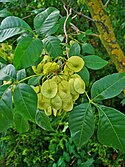
|
NYFA: 1-2 |
USDA-NN Go Botany VASCAN ARS-GRIN ITIS Tropicos Images Wikispecies |
|
| |||||
Phellodendron
[edit | edit source]| Genus Phellodendron | Corktree | N.Y. Status | Images | Distribution | NY NPT |
Rupr. 1857. Phellodendron amurense Rupr. 1871. Phellodendron japonicum Maxim. 1905. Phellodendron sachalinense Sarg. 1909. Phellodendron lavallei Dode |
Amur corktree, Chinese corktree Phellodendron de l'Amour, Arbre liège de Chine, Phellodendron de Sibérie |
Introduced from temperate Asia, Highly invasive, NYIS: 75%[1], Prohibited[2], NYS Tier 4[3] |

|
NYFA: X |
USDA-XX Go Botany VASCAN ARS-GRIN ITIS Tropicos Images Wikispecies |
Dictamnus
[edit | edit source]The gasplant gets its name from the volatile citrus-scented oil produced by its leaves.
| Genus Dictamnus | Dictamnus | N.Y. Status | Images | Distribution | NY NPT |
L. 1753. Dictamnus albus L. 1805. Dictamnus fraxinellus Pers. 1840. Dictamnus fraxinellusvar. caucasicus Fisch. & C.A.Mey. 1932. Dictamnus caucasicus Grossh. |
Gasplant, Dittany, Burningbush |
Introduced from Eurasia, Not naturalized Perennial, Herb-forb |

|
NYFA: X |
USDA-X0 Go Botany ARS-GRIN Images Wikispecies |
|
| |||||
Family Meliaceae
[edit | edit source]The Meliaceae (mahogany family)...
Subfamily Melioideae
[edit | edit source]Tribe Melieae
[edit | edit source]Melia
[edit | edit source]
|
| Genus Melia | Melia | N.Y. Status | Images | Distribution | NY NPT |
Chinaberry tree
Bead Tree
China Ball Tree
Paradise Tree
Persian Lilac
White Cedar
Japanese Bead Tree
Texas Umbrella Tree
Pride-of-India
|
Introduced, Potentially invasive, iMapInvasives, Invasive.org: [1], No NY specimens, FEIS |

|
NYFA-Excluded NYFA: Excluded iNat GBIF Queens (2019) |
USDA-X BONAP Images Wikispecies | |
|
| |||||












































